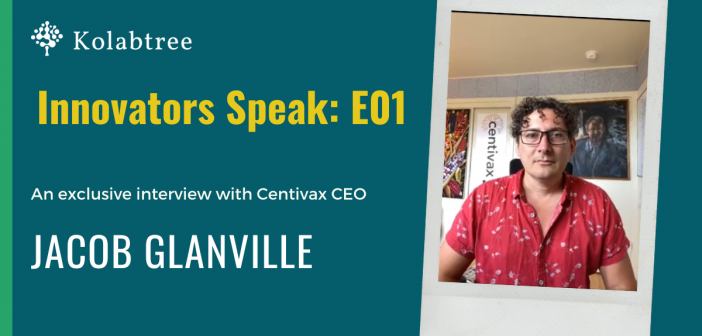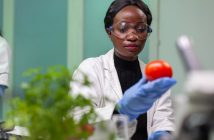This article is the first in a series of Innovators Speak, where Kolabtree chats with the world’s leading scientific and business innovators such as Jacob Glanville, and picks their brains on the latest advancements in science and technology, how academics are switching to remote working within a rapidly burgeoning expert economy, how the pandemic is shaping our future and much more.
In this interview, Jacob Glanville sits down with Kolabtree CEO Ashmita Das to discuss Centivax going into clinical trials on June 1 with their SARS COV 2 antibody vaccine, and how maintaining a lean model has helped keep the costs down.
Jacob Glanville is an immuno-engineer and entrepreneur, developing the core business model and technology for Distributed Bio and its spin-off Centivax. Both companies follow a lean business model to minimise redundancy and maximise efficiency, resulting in sustained profits without external investment.
Here, Jacob Glanville (JG) sits down with Ashmita Das (AD), CEO of Kolabtree, to discuss Centivax’s experience of going into clinical trials with its SARS COV 2 antibody vaccine, and how maintaining a lean model has helped keep costs down.
AD: Jacob, you have an incredible career history to date — you’ve received grants and awards from the Gates Foundation, you are a National Institute of Health principal investigator and have been featured in a Netflix documentary.
You were a guest lecturer at Stanford and USF and are also a principal scientist at Pfizer. In 2012, you co-founded Distributed Bio and you are now running its spin off Centivax, making you a serial entrepreneur and inventor, computational immuno-engineer, among other things.
How would you describe yourself in your work?
JG: I’m an immune hacker, so I use mathematics, computers and good old-fashioned roll up your sleeves wet lab work to interrogate the immune system and figure out how to get the best responses out of it. This information can help us treat various diseases and harness therapeutic molecules directly out of the immune system, like monoclonal antibodies that can serve as drugs.
The immune system affects pretty much every disease — from the obvious things like infections to other conditions like cancer, nerve degeneration and heart disease. You’re often hard–pressed to find somewhere in medicine where the immune system isn’t involved because your immune system is designed to detect changes in tissues, and that’s what disease is.
And then on the flipside, it’s also a great source of medicines like antibodies and allows us to develop our understanding of how to produce better broad-spectrum vaccines. All these cool applications have become much easier to attack with vigour with the emerging golden age of biotechnology. We have high-throughput genomic sequencing instruments, high-throughput DNA synthesis instruments, and a plethora of single-cell sequencing technologies and microfluidics. Therefore, part of my job is understanding that system and coming up with engineering tactics for creating medicines that can treat problems that have plagued us since the beginning of time.
AD: Can you talk a little bit about your latest venture, Centivax? What’s the vision for this new company?
JG: This has been my long-range plan and dream and I’ve finally been able to manifest it. Centivax was founded on the idea of being able to harness the technologies that I spent time optimising and engineering first as an advisor and then in my first venture Distributed Bio. Now I’m finally ready, with a decade of research, to use these technologies to build antibodies or even provoke them out of a living organism that bind to the Achilles heels of viruses and pathogens. When you get the right antibody against that special site, they tend to be much more effective. In the case of the coronavirus, we are now getting ready to start our clinical studies on an antibody.
With our broad-spectrum vaccine technology, we teach the immune system to make specific antibodies. For a snake bite, we could develop a vaccine from someone whose body had generated antibodies that were able to bind to sites across venom from all snakes — this is the kind of application I’d like to tackle. There are also important applications in autoimmunity and oncology, where you are targeting mutating and diverse populations, and we could hack those systems well. That’s the strength of our technology, our goal is creating substantial advances using new technologies to attack these systems.
AD: So when you say you’re immuno-hacking, what you’re trying to do is take the natural responses our bodies produce and use that as the therapeutic.
JG: We extend beyond what the human body can produce. The problem with the human body is that when pathogens, cancers and autoimmunity strike, they have hacked our immune system. There’s this never-ending arms race of trying to have a diversity of the pathogen or the cancer against the diversity of our immune system. And these two armies have met at war since the beginning of time, and they both learned each other’s weaknesses. And that’s where the stalemate arises and you get sick.
We engineer beyond what nature can deliver. We learn how to use these systems so we can hack beyond where nature naturally gets stuck. That’s nature — it doesn’t normally produce a broad, neutralising response against all influenza and, for instance, we don’t currently have a working HIV vaccine.
That’s where our technology comes in. We ask ourselves, where is the defect, and then we engineer to try to push beyond what nature has provided so that we can actually win some of these forever wars against pathogens. The golden age of biotechnology can help us push back past the stalemate and achieve victory. And I will say that sounds ambitious, but I’ll remind you we were able to eradicate smallpox, and we have almost eradicated several other pathogens. There has been remarkable success in vaccine science and multiple Nobel Prizes awarded around monoclonal antibodies.
But those technologies are still operating based on last century’s biotechnology capabilities, so we’re bringing in new technologies to be able to make better engineered medicines to break through the continued limitations of nature.
AD: With Centivax you’re currently creating an antibody therapeutic treatment for the coronavirus, and I understand it’s going into clinical trials. What’s the progress on this and what role do you see it playing?
JG: I initiated this programme at the beginning of the outbreak and, because my team specialises in pandemic medicine, we knew right away there were going to be two big problems to address.
We knew the virus was going to start mutating and so there were efforts to produce antibody therapies quickly. When they came out, many were already being revoked by the FDA because the new mutant versions of the virus, which are more infectious and may be more deadly, were causing those early antibodies to no longer bind effectively to the virus. We spent the time engineering an antibody that binds to an Achilles heel, a very sensitive part of the virus on all the new emerging strains.
Secondly, I could anticipate that it was going to be a major problem to try to deliver a normal antibody therapy in the midst of a pandemic, and the reason for that is that with normal antibody therapies you have to give a big dose in an infusion bag, and that means having a specialist treat you in an infusion centre.
The problem in a pandemic is that in any location where you could receive an IV, those areas are already full of very sick patients. The best time to give an antibody therapy is as early as possible — the problem is if you call immediately and request the antibody therapy, the doctors will likely say that you’re not sick enough. But then you risk getting sicker, so by the time you arrive you’re in a much worse position — this was a problem we wanted to address and that’s where our engineering advantage comes in. We were able to engineer an antibody to produce ultra-high concentrations that fit into an injectable syringe. Therefore, patients don’t need to go to an infusion centre, they just get a pop in the arm or in the leg and get the medicine early. We can deliver a smaller dose and we can give it much earlier, which means we can produce many more doses than beforehand.
This is a powerful way to transform how scary this pathogen is — you can get a shot early so you don’t get sick in the first place. You don’t risk going to the hospital. You don’t risk death and we believe that it will avoid some of the long-collar risk of the complications that arise from a serious infection.
AD: So if you don’t mind just digging a little deeper. You know giants like Pfizer, they obviously do have a critical role to play in very many areas, including funding, mass producing drugs and driving large scale clinical trials.
But I also firmly believe that a lot of innovation happens on the ground among smaller biotech or other types of organisations. These are probably organisations with less than 100 people. Would you agree? Do you think that a lot of the innovation is driven by smaller players?
JG: The answer is yes, and here’s why. I spent four years working at Pfizer, which was a juggernaut. I then spun out to create my first and now second company. In Distributed Bio, my first company, I ended up running 78 antibody discovery and optimisation programmes for about 60 different pharmaceutical and small biotech companies. Through that process, I ended up meeting hundreds of companies, many of which became my clients and these ranged from major pharmas to small biotechs, and that gave me an opportunity to watch the trends in the industry and see how they were shifting.
The big change is that traditionally everything occurred within the hallowed halls of a major pharmaceutical company. You had a department for hybridoma, a department for manufacturing, a department for safety etc. Modern pharma has split that out into a constellation of contract research organisations (CROs), which has enabled many of my previous clients and now my own company to run clinical trials and to partner with. For example, we partnered with Charles River Laboratories for safety and talks, and with another regulatory specialist to do our clinical study with the military.
There are groups you can reach out to, and big pharma companies have realised this and started downsizing. They keep themselves strategically lean. They have a key set of experts that are difficult to outsource because that’s central to their core mission, but, otherwise, they reach out to either consultants or to contract groups when they can.
Of course you want to establish good relationships with CROs or consultants. However, you may want them, for a period of, say, four months, and then you don’t need them again. But if you like them, you call them up again six months from now, and it’s that periodic access and the use of an existing expert outside without having to build everything internal that allows companies like mine to remain relatively lean.
To watch the full interview with Jacob Glanville, visit https://www.kolabtree.com/blog/innovator-speak-kolabtree-interviews-centivax-ceo-jacob-glanville/.
Watch Jacob Glanville talk about specific issues such as vaccinations and the growing significance of biotech here – https://www.youtube.com/channel/UCLAvq8HIDTKahLWzYoY2rgg/videos






